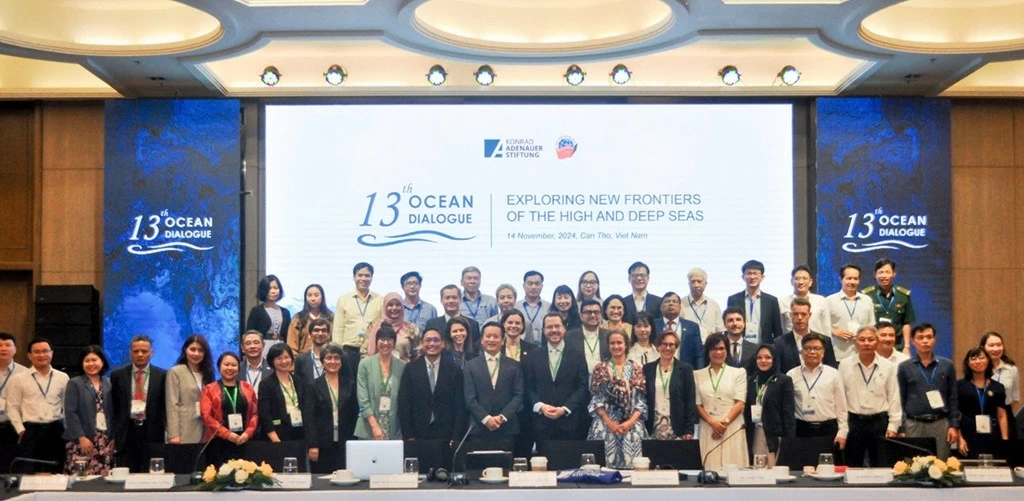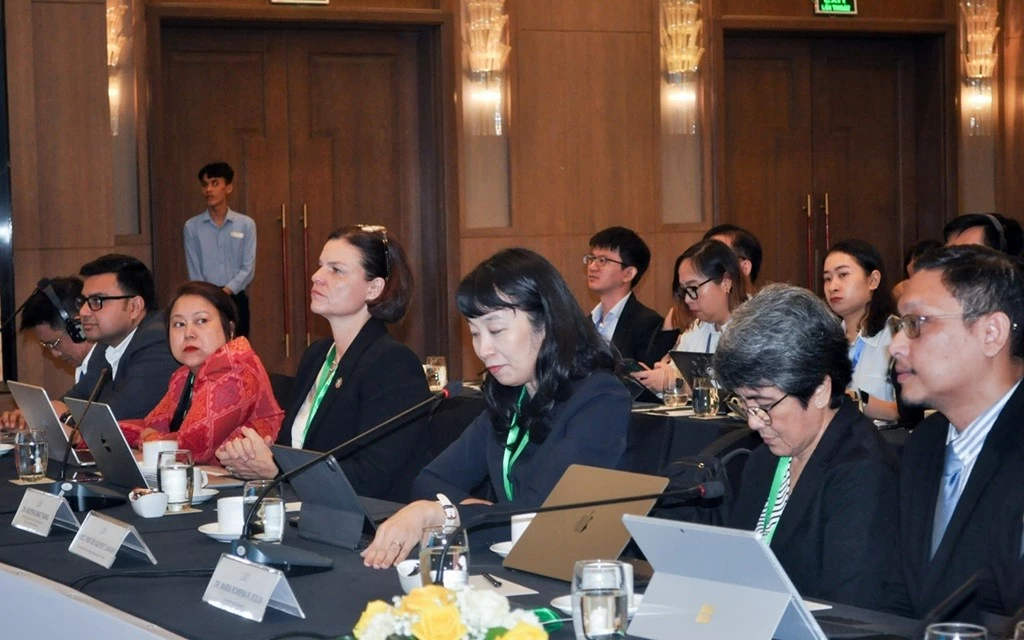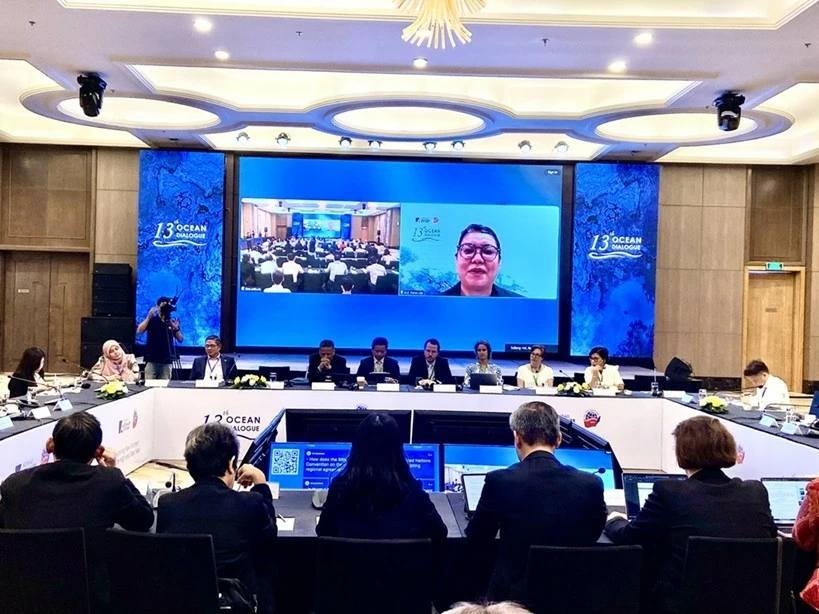The Treaty of the Seas – BBNJ (Part II): 20 years of “sowing seeds, sprouting”, carrying a separate mission
https://www.vietnam.vn/en/hiep-uoc-bien-ca-bbnj-ky-ii-20-nam-gieo-hat-nay-mam-mang-mot-su-menh-rieng/
November 14, 2024

Within the framework of the 10th 13 Ocean Dialogue, held in Can Tho City (14/11), domestic and international scholars and jurists “dissected” the significance of the Agreement within the framework of UNCLOS on the conservation and sustainable use of marine biodiversity in areas beyond national jurisdiction (BBNJ). The achievement of BBNJ is a milestone of international law, but there is still a long way to go before it can be put into practice.
 |
| Delegates pose for a group photo at the 13th Ocean Dialogue. The dialogue focused on discussing the role of the BBNJ Agreement. (Photo: Pham Hang) |
New points to catch up with the trend
Associate Professor, Dr. Nguyen Thi Lan Anh, Director of the East Sea Institute (Diplomatic Academy) emphasized that there are four areas of BBNJ that can support the implementation of UNCLOS in the coming time, including: BBNJ provides important definitions; BBNJ stipulates responsibilities for cooperation on marine resources or technology transfer; clearinghouse mechanism – providing, sharing information and facilitating cooperation; periodic monitoring mechanism as well as capacity building.
More specifically, Associate Professor Dr. Modh Rusli, Universiti Sains Islam, Malaysia said that BBNJ has provided important tools and research with specific tasks to prevent problems related to environmental degradation. The treaty ensures that these efforts are not carried out in isolation, but promote cooperation.
Dr. Tran Thi Ngoc Suong, University Da Nang also affirmed the significance of BBNJ’s establishment of rules with specific and detailed procedures to implement UNCLOS, thereby assessing the impact on the marine environment.
According to Dr. Tran Thi Ngoc Suong, it is important that human activities are assessed to reduce negative impacts on the environment, ensuring compliance with the BBNJ. In the BBNJ, countries are responsible for conducting marine environmental impact assessments. Activities within national jurisdiction can also have environmental impacts beyond national jurisdiction.
“UNCLOS has provisions on the parties’ responsibilities towards the environment, but BBNJ is more detailed in assessing the threshold of environmental impact, followed by a consultation process to include in the report, thus, being able to address challenges and assess the impact of activities outside national jurisdiction,” Dr. Tran Thi Ngoc Suong emphasized.
 |
| Associate Professor, Dr. Nguyen Thi Lan Anh, Director of the East Sea Institute chaired the discussion session “BBNJ Agreement: Main contents and prospects”. (Photo: Pham Hang) |
Adding to the new points of BBNJ, Dr. Sarah Lothian, University of Wollongong, Australia, said that Part 14 of BBNJ has assessed marine technology transfer as an important and indispensable element in implementing other elements. Therefore, countries need to participate and contribute responsibilities through sharing research, financial support, and technology transfer.
“The key here is a long-term vision as well as a long-term dialogue between stakeholders on technology transfer, facilitating and inspiring developed countries to transfer marine technology to developing countries,” Dr. Sarah Lothian emphasized.
Dr. Sarah Lothian said that there are provisions that are only found in BBNJ but not in UNCLOS, such as progress reports to ensure transparency, which can promote the implementation of BBNJ among member states.
 |
| Delegates discuss enthusiastically at the 13th Ocean Dialogue. (Photo: Pham Hang) |
“The more countries that join BBNJ, the better”
Sharing online within the framework of the Dialogue, Ms. Rena Lee, Ambassador of Singapore for Ocean Affairs and Law of the Sea, Executive Chair of the United Nations Intergovernmental Conference on the BBNJ Agreement, emphasized that the BBNJ requires comprehensive participation and ratification by as many countries as possible. Each country must make its own efforts to ensure this ratification process in parallel with the assessment of the opportunities and challenges posed by the BBNJ.
According to Ms. Rena Lee, the US has been involved since the BBNJ opened for countries to sign. The White House also issued a press release stating that the US will work to ratify the BBNJ. However, the US legal system will actually take a long time and be challenging to ratify the Agreement.
“The process of achieving BBNJ took 20 years. Therefore, it is necessary to raise awareness about the meaning and importance of BBNJ. Ratification is only part of the post-ratification process, we also have to prepare for the implementation process. We need to start discussing the implementation of BBNJ early, so that BBNJ can be applied immediately after it comes into effect,” Ms. Rena Lee emphasized.
 |
| Ms. Rena Lee, Singaporean Ambassador for Ocean Affairs and Law of the Sea, Executive Chair of the United Nations Intergovernmental Conference on the BBNJ Agreement, shared online within the framework of the Dialogue. (Photo: Pham Hang) |
Ms. Rena Lee expressed her general hope that BBNJ will remain relevant in the future, even when the situation changes. According to her, BBNJ needs to have the necessary flexibility, adapting to changes in practice. Obviously, BBNJ has some provisions that emphasize and supplement the provisions in UNCLOS, in many aspects, BBNJ provides more.
Dr. Kristine Dalaker, National Center for Marine Resources and Security, Australia, assessed that BBNJ still has aspects that have not been deeply mentioned, such as the submarine cable network, in the context of this network becoming increasingly diverse and sophisticated, becoming an important part of dialogues on sustainable development.
Therefore, when BBNJ is implemented, activities related to submarine cables will also face many challenges. However, “The Agreement is only one year old and it takes time to learn about BBNJ and we are optimistic about the birth of this Agreement”, Dr. Kristine Dalaker shared.
Sharing the same optimistic attitude about BBNJ, Dr. Mary Kristerie Baleva, Stratbase ADRi Philippines Institute, said that there are still 6 years left for countries to achieve the sustainable development goals, so there is still much work to be done ahead and “time waits for no one”.
According to Dr. Mary Kristerie Baleva, countries need to cooperate to ratify and implement the BBNJ, creating a common momentum to minimize the impacts of climate change and environmental pollution.
| Ms. Liz Karan, Director of the Ocean Governance Program, Pew Charitable Trust (USA): “BBNJ does not go against but respects existing international institutions. Currently, 105 countries have signed BBNJ and only 14 countries have ratified it, so 60 more signatories need to ratify it for BBNJ to officially come into effect. Hopefully, BBNJ will come into effect by the time of the United Nations Blue Ocean Conference in 2025.” |
BBNJ was established in the context of existing legal frameworks and rules governing deep seabed mining activities such as regulations issued by the International Seabed Authority (ISA), the 1994 Agreement relating to the implementation of Part XI of UNCLOS, etc.
However, Dr. Digvijay Rewatkar, Research Fellow, Centre for International Law, National University of Singapore, asserted that BBNJ maintains a balance between the obligations and interests of states and does not undermine the value of existing international agreements or mechanisms. “BBNJ can complement rather than overshadow existing instruments, enabling existing mechanisms to play a role in the areas covered by BBNJ,” said Dr. Digvijay Rewatkar.
